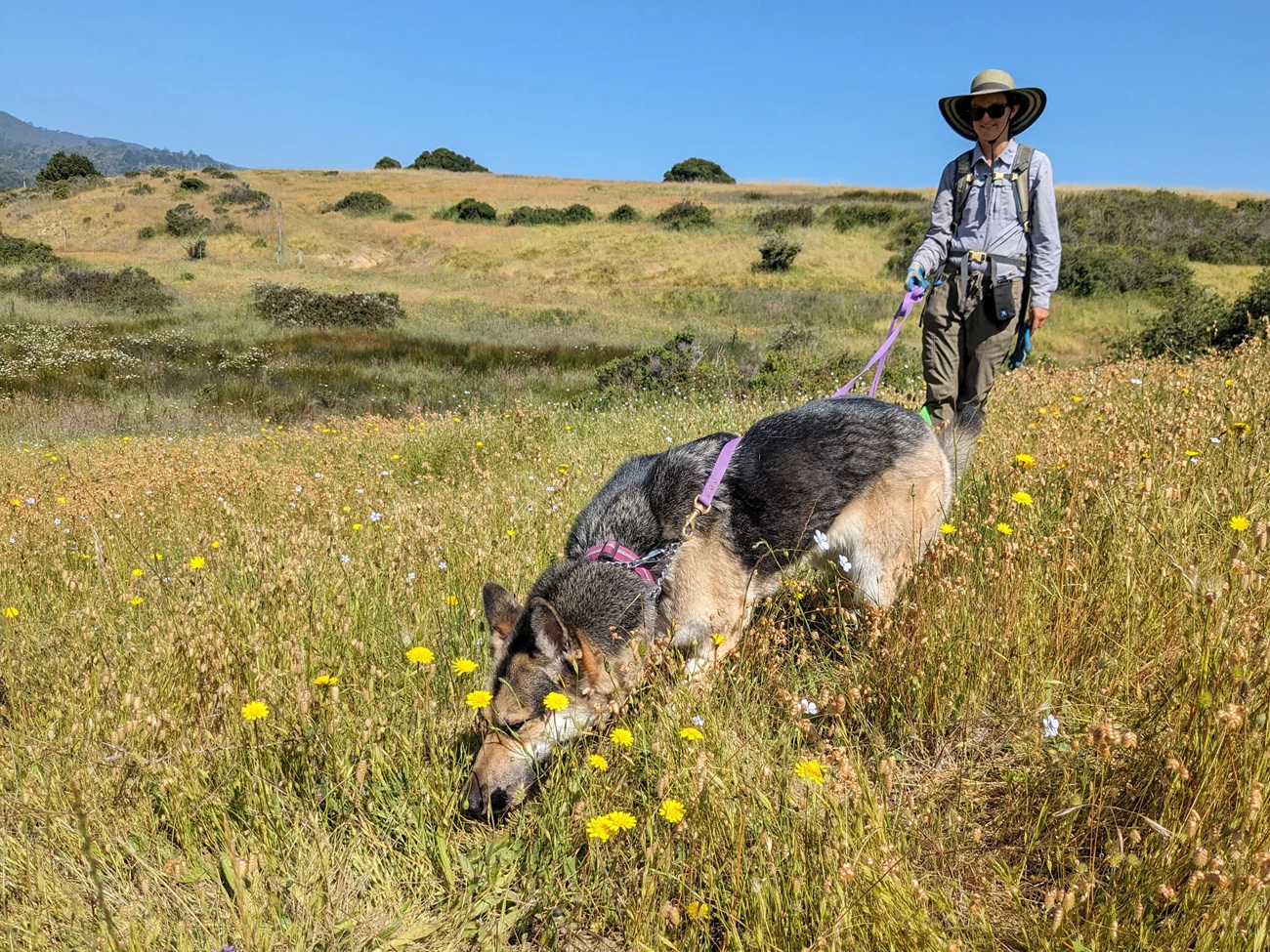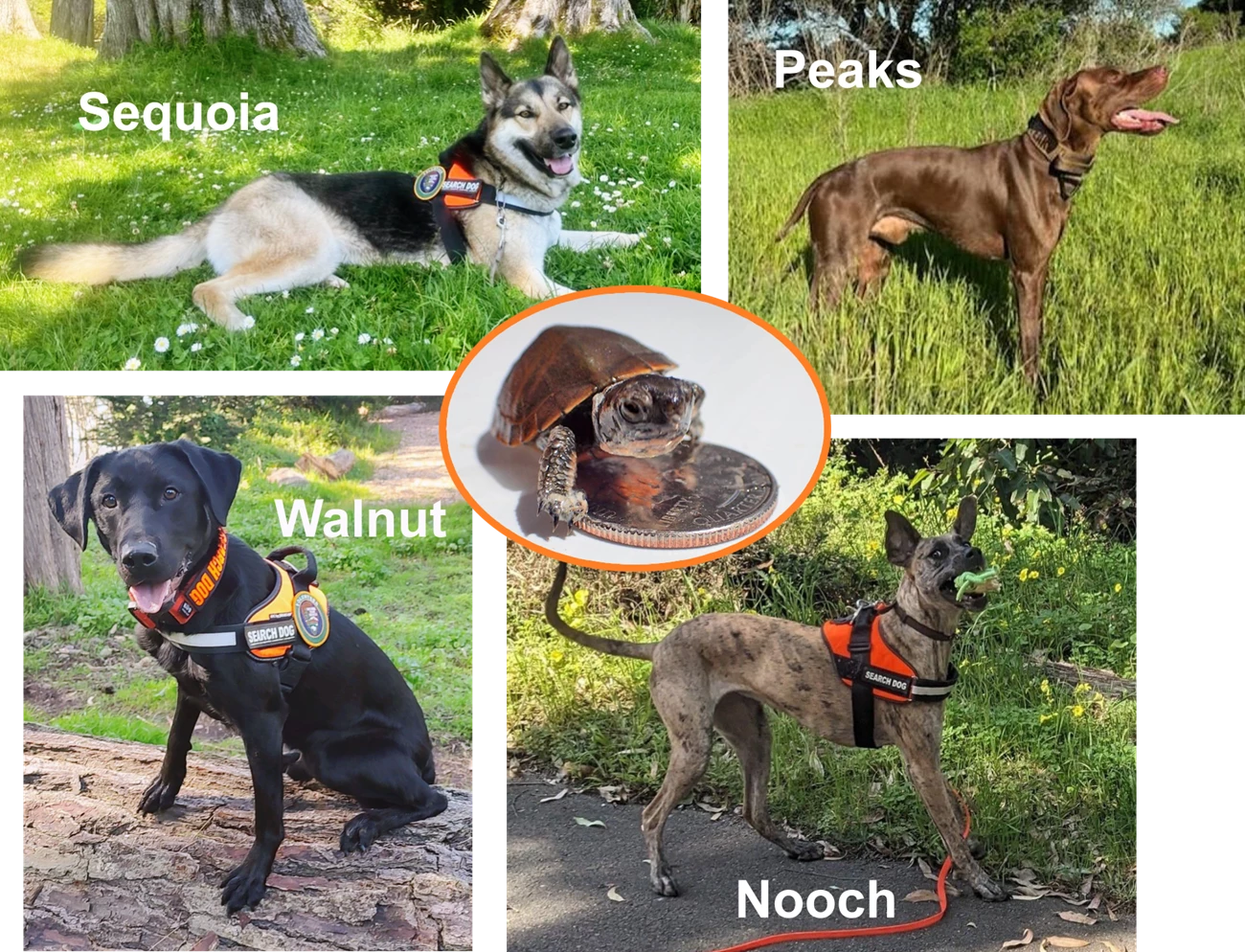Last updated: September 29, 2025
Article
Biologists Enlist Best Noses in Town to Protect At-risk Turtles
By Wildlife Biologist Katie Smith, Golden Gate National Recreation Area; and Science Communication Specialist Jessica Weinberg McClosky, San Francisco Bay Area Inventory & Monitoring Network

NPS / Katie Smith
May 2024 - We may not be able to swim around and bask in the sun every day like western pond turtles. Nor do we need to, being warm-blooded. Still, spotting a basking turtle can be a fun reminder to slow down our busy lives where we can. Thanks to park biologists and partners, visitors again have turtle-spotting opportunities in popular parts of Golden Gate National Recreation Area and the Presidio of San Francisco where they had vanished. But the turtles still need help growing their numbers. Cue an unlikely conservation hero: Canis lupus familiaris, the domestic dog! This May and June, specially trained dogs are helping biologists find and protect vulnerable turtle nests in the park.

NPS
Western pond turtles are California’s only native freshwater turtle, and a state species of special concern. They’re also under review for listing under the federal Endangered Species Act. Populations have declined steeply as they lost much of their wetland habitat to development. Disease and invasive species like red-eared sliders and American bullfrogs also threaten turtles.
So in 2015 Presidio biologists teamed up with Sonoma State University researchers and the San Francisco Zoo to reintroduce western pond turtles into Mountain Lake. And from 2016 to 2023, Golden Gate biologists got the team back together to give the turtles another boost. They raised the turtles at the zoo and reintroduced them back to two restored park wetlands. Now the challenge is getting populations big enough to be self-sustaining. Nest survival is the biggest barrier. On average, mammals like skunk, fox, and raccoon eat 80 percent of western pond turtle nests within the first few days of eggs being laid. Park biologists wondered if trained dogs could help them find turtle nests first.

NPS / Wendy Baker

NPS / Katie Smith

NPS / Wendy Baker
Each team consists of a dog and their handler. There are four teams: Golden Gate Wildlife Biologist Katie Smith and their dog Nooch, and three incredible, dedicated volunteers and their working dogs Peaks, Walnut, and Sequoia. After initial evaluations and one year of training, teams completed rigorous odor recognition tests and field trials. Then they were ready for their first turtle nest surveys.
Throughout the months of May and June, dog teams will be searching for nests at Muir Beach, Mountain Lake, and near Tomales Bay. When teams find nests, biologists will record them and use wire mesh and stakes to protect them from digging predators. This year is a trial year for this novel monitoring and conservation technique. If all goes well, dog teams will assist during future seasons to count and protect turtle nests.

NPS
For more information
- B.A.R.K. Rangers
- Contact Golden Gate Wildlife Ecologist Bill Merkle
- A Record Year for Western Pond Turtle Reintroductions
Acknowledgements
Park staff would like to thank Ashley Hisey, Jennie Keifer, Elizabeth Merritt, and their incredible dogs for their service. Their tireless efforts, dedication, and enthusiasm have made this project possible.See more from the Bay Area Nature & Science Blog
Tags
- golden gate national recreation area
- point reyes national seashore
- presidio of san francisco
- sfan
- blog
- reptiles
- turtles
- western pond turtle
- at-risk biota
- conservation
- bark rangers
- bark ranger
- detection dogs
- working dogs
- volunteers
- volunteers in parks
- katie smith
- jessica weinberg mcclosky
- resource management
- science
- mountain lake
- muir beach
- tomales bay trail
